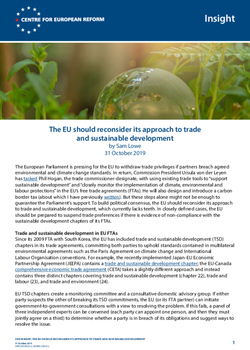
The EU should reconsider its approach to trade and sustainable development
In specific circumstances, the EU should make trade concessions contingent on partner countries meeting international environmental and labour standards. This will better align the EU’s trade and sustainability agendas, and increase support for openness.
The European Parliament is pressing for the EU to withdraw trade privileges if partners breach agreed environmental and climate change standards. In return, Commission President Ursula von der Leyen has tasked Phil Hogan, the trade commissioner-designate, with using existing trade tools to “support sustainable development” and “closely monitor the implementation of climate, environmental and labour protections” in the EU’s free trade agreements (FTAs). He will also design and introduce a carbon border tax (about which I have previously written). But these steps alone might not be enough to guarantee the Parliament’s support. To build political consensus, the EU should reconsider its approach to trade and sustainable development, which currently lacks teeth. In closely defined cases, the EU should be prepared to suspend trade preferences if there is evidence of non-compliance with the sustainable development chapters of its FTAs.
Trade and sustainable development in EU FTAs
Since its 2009 FTA with South Korea, the EU has included trade and sustainable development (TSD) chapters in its trade agreements, committing both parties to uphold standards contained in multilateral environmental agreements such as the Paris Agreement on climate change and International Labour Organisation conventions. For example, the recently implemented Japan-EU Economic Partnership Agreement (JEEPA) contains a trade and sustainable development chapter; the EU-Canada comprehensive economic trade agreement (CETA) takes a slightly different approach and instead contains three distinct chapters covering trade and sustainable development (chapter 22), trade and labour (23), and trade and environment (24).
EU TSD chapters create a monitoring committee and a consultative domestic advisory group. If either party suspects the other of breaking its TSD commitments, the EU (or its FTA partner) can initiate government-to-government consultations with a view to resolving the problem. If this fails, a panel of three independent experts can be convened (each party can appoint one person each, and then they must jointly agree on a third) to determine whether a party is in breach of its obligations and suggest ways to resolve the issue.
However, EU TSD chapters are not subject to enforceable dispute settlement procedures and there are no financial penalties for non-compliance. The lack of sanctions has led to claims by MEPs and civil society groups that EU TSD chapters are toothless in practice. European civil society groups also point out that there is an imbalance in how their concerns and those of investors are treated: under the investment protection mechanisms contained in many EU trade agreements, foreign investors are able to sue for financial compensation in the event that government action is adjudged to have harmed their investment; groups concerned about labour abuses and environmental degradation, on the other hand, have limited recourse.
The US and Canada adopt a different approach from the EU when it comes to the enforcement of TSD commitments in their respective FTAs. (These commitments are also narrower in scope and cover fewer issues, in general.) US TSD chapters are covered by the FTAs’ dispute settlement mechanisms; in the event that a dispute settlement panel finds that a failure to meet the labour or environmental commitments has had a quantifiable impact on trade flows, trade concessions may be withdrawn. Canadian FTAs (excluding CETA) allow for dispute settlement cases to be brought exclusively in the event of trade-related labour provisions being violated; if the panel finds in favour of the complainant then a proportionate fine can be levied.
The Commission has responded to claims that EU TSD chapters lack bite. In 2017 it published a non-paper seeking feedback on its approach to TSD and whether to continue with the existing approach, but improve upon it, or whether to move to a more US/Canadian-style enforcement regime. In 2018 the Commission published its response to the consultation in a second non-paper. This second paper concluded that pursuing a sanctions-based approach to enforcing EU TSD chapters was not desirable, and instead recommended improving the existing model: to increase transparency and implement a more assertive approach to enforcement under the existing mechanisms.
Since the publication of these recommendations, the EU has taken action against Korea, asking for a panel to be convened under the EU-Korea FTA. The reason the EU gave was that Korea had failed to deliver on its TSD commitments to ratify and fully implement a number of International Labour Organisation conventions.
Alternative approaches to enforcement
However, the EU’s trade agreement with the Mercosur trade bloc, which is awaiting Council and European Parliamentary ratification, has put the subject of TSD enforcement back on the agenda. This is largely in response to Brazilian president’s Jair Bolsonaro’s anti-environment domestic agenda and a summer in which fires raging in the Amazon made global headlines. The Green members of the Parliament’s international trade committee declined to endorse Hogan’s nomination as trade commissioner partly because he lacked “ambition” on TSD enforcement. MEPs have also been pushing for the TSD chapter in a possible EU-Australia agreement to be “state of the art”.
Yet the Commission’s aversion to a sanctions-based approach to TSD is understandable. There is little evidence to suggest that the US’s approach is more effective than the EU’s. No formal case has ever been brought under the environmental provisions of any US FTA. Of the complaints received since 1994 by the Office of Trade and Labor Affairs, the US body responsible for reviewing allegations of FTA labour violations, only one case has been subject to dispute settlement: a claim that Guatemala was not enforcing its labour laws on acceptable conditions of work and trade union rights.

The case against Guatemala ultimately failed because the US was unable to demonstrate that Guatemala’s failure to enforce labour law had affected trade between the US and Guatemala, and that it was the result of sustained action or inaction. In practice, it is often impossible to prove a direct link between labour or environmental practices and trade flows, making the necessary conditions for a successful case an impossibly high bar to clear. Through this lens, the enforcement provisions look more performative than substantive. A representative of the US labour movement described the result of the Guatemala case as “failure by design”.
Furthermore, before bringing a formal case against a country on the basis of its labour or environmental record, a government will inevitably take into account other political and diplomatic factors. Academic research suggests that the EU’s existing TSD model of dialogue and consultation does improve conditions in partner countries. There is, as yet, no evidence that the sanctions-based model does the same. Governments prefer to use diplomacy rather than bringing a trade dispute against an FTA partner, which could have broader political consequences.
However, much of the criticism of the US’s approach is that its enforcement provisions are ineffective, rather than the principle of enforcement itself. There is nothing preventing other countries, and indeed the EU, from expanding in future agreements the relevant criteria for assessing whether a party is in breach of a specific commitment beyond those narrowly applied by the US in its FTA with Guatemala. For example, the treaty text could make preferential trade treatment explicitly contingent on continued compliance with a particular multilateral environment agreement or labour treaty.
Indeed, in its recent trade negotiations the US has sought to strengthen enforcement in specific circumstances. When negotiating the Trans-Pacific Partnership (a plurilateral trade agreement which the Trump administration ultimately withdrew from), the US negotiated parallel bilateral labour agreements with three TPP countries, which clarified the criteria partner countries were expected to meet, increased the levels of monitoring, and allowed the US to withdraw tariff concessions in the event of non-compliance. In the case of Vietnam, for example, after five years of the agreement being in place, if the US had found that Vietnam had failed to ensure the rights of workers freely to form and join a labour union of their choosing, the US could have withheld or suspended tariff reductions.
At the more extreme end, the newly negotiated (but not yet in force) NAFTA update, the USMCA agreement between the US, Canada and Mexico, requires 40-45 per cent of automobile content to have been made by workers earning at least $16 per hour if the company concerned is to qualify for zero-tariff trade.
Where to go from here
Despite the limitations of the existing US approach to TSD commitments, calls for the EU to move towards a more American, sanctions-based, approach are here to stay. And if the European Parliament is to ratify the Mercosur association agreement, and future EU FTAs, its concerns about the EU’s existing approach to TSD chapters in FTAs will need to be addressed.
The EU should not be lured into a false choice; rather than jettisoning its existing model entirely and replacing it with a new one, the EU should instead build upon existing approaches. Dialogue and consultation should remain the primary tool for engaging with FTA partners on TSD issues, but supplementary unilateral removal of trade preferences could be linked to specific areas of concern. Dispute settlement could then exist solely as a fall back, allowing the partner country to challenge the EU’s decision if it disagrees.
In the case of Mercosur, continued EU tariff concessions on agriculture could be made conditional on the Mercosur countries meeting their Paris Agreement carbon reduction targets, such as Brazil’s commitment to reduce greenhouse gas emissions by 37 per cent below 2005 levels by 2025. If Brazil, in this instance, looked likely to miss its target in the run up to 2025, the first step should be consultation and engagement between the parties, with a view to the EU providing assistance where appropriate. The EU would only be able to suspend tariff preferences once it had explored all other avenues.
Adding extra teeth to the EU’s TSD repertoire is not without its risks. Doing so might make it more difficult for the EU to sign FTAs with certain countries in the first place. And it will be a political challenge to decide which environment and labour goals should be subject to tariff conditionality in FTAs. However, the risks should not be overstated. Such an approach will probably not scupper negotiations with Australia and New Zealand, where it is unlikely (although not impossible) that there would ever be cause for the EU to threaten tariff re-imposition. In the case of Mercosur, the aim would be to lock in specific existing international commitments, and guard against backsliding, rather than to create new ones.
In any event, the days in which European trade policy could be considered in a vacuum, free from broader social objectives are gone. If approached strategically, beefing up the EU’s approach to TSD would not only make it easier to win MEP backing for new FTAs, it could also provide an effective means of ensuring that partner countries continue to abide by their international labour and environmental obligations.
Sam Lowe is a senior research fellow at the Centre for European Reform.


Add new comment